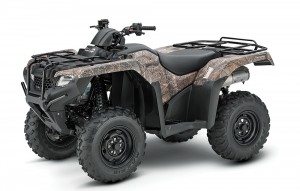Honda expands IRS offerings for 2015
Conquest sales expected to follow intro of Independent Rear Suspension
Honda already holds its own in the ATV market as the U.S. market share leader. But as the OEM has added independent rear suspension (IRS) to more models, it expects to continue to grab share from its competitors.
“We dominate that straight-axle market because we’re one of the few manufacturers that really cater to that market,” said Lee Edmunds, manager of motorcycle marketing communications at American Honda. “In the IRS market, we’ve been not very strong at all, and now that we’re coming with that full line, we expect to see a lot of conquest sales there.”
Honda in the 2015 model year introduced IRS to its Rancher and Rubicon ATVs and has already seen success with those, a trend the OEM expects to continue as the 2016 models become available this spring and summer.

Continued leadership
U.S. ATV sales decreased for several years starting in the mid-2000s, but since 2011, they’ve seen slight increases. In the meantime, Honda has held strong to its market leadership and continued to innovate.
“It’s a market we’ve dominated since the very beginning of all-terrain vehicles, from the very first ATC and the ATC 90 in the 1970s to all the way up to today, so it’s an important market to Honda,” Edmunds said. “We build them here in South Carolina, so it’s important to everybody in our factories. It’s a huge pride point for us and the customers as well. It’s one of those things where we built that market up for so many years — we do get a lot of repeat customers, and they just keep coming back to the brand. So there’s a responsibility there, too, to continue to deliver on that Honda brand name to all our customers.”
Honda’s ATVs are built in South Carolina, while the OEM’s ATV R&D facilities are housed in Ohio, and American Honda’s headquarters are in California. Having all of those resources within the No. 1 ATV market has been beneficial for
the OEM.
“Everything being in the U.S. gives us really good communication between the groups to really anticipate what customers need and to be able to react to that quickly, so that’s probably the biggest benefit to having everybody at the spot,” Edmunds said.
Honda’s customers
In the ATV market, Honda’s demographic is just over half recreation, with the rest focused on utility. But Edmunds says it’s often the utility user that drives the recreational buyer to choose Honda.
“We have a tremendously loyal fan base there, so we have these customers that buy their ATVs for agriculture use year after year after year, and those people also are outdoor enthusiasts. They’re hunters; they’re fisherman; they go out and do that on the weekends and in their spare time,” Edmunds said. “That word of mouth from that base has really helped us in that recreational market, and that’s where we think the opportunity for us to continue to offer that straight-axle machine, to continue to serve that farm and ag market. But now with the IRS machine, we’ll even serve the recreational market even more.”
In addition to the IRS, also bringing in customers is Honda’s Dual Clutch Transmission (DCT).
“The DCT automatic is a reliable, mechanical transmission, so that’s been a strong selling point for our models,” Edmunds said.








